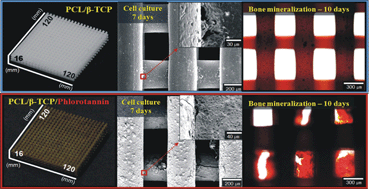In general, a biomedical scaffold should have a three-dimensional (3D) shape that is structurally and mechanically equivalent to the replaced tissue, and afford biologically attractive sites for the injected cells to attach, proliferate and differentiate. In this study, we designed composite scaffolds consisting of poly(ε-caprolactone) (PCL), β-tricalcium phosphate (β-TCP), and phlorotannin fabricated by a combined melt-plotting and coating system for bone tissue regeneration. The pore size and porosity of the multilayered composite scaffolds were fixed at 300 μm and 55%, respectively. Phlorotannin, which exists in brown algae, has been reported to have several biological growth factors for tissue regeneration. However, phlorotannin has not been investigated in terms of cellular activity at various compositions in a 3D pore structure. The effect of phlorotannin composition (1, 3, and 5 wt%) on various physical characteristics including the surface roughness, water-absorption ability, and mechanical properties was investigated. Based on water absorption, the phlorotannin in the composite scaffolds induced marked wettability compared to the PCL/β-TCP composite scaffold. The in vitro biocompatibilities of the composites were examined using osteoblast-like cells (MG63). Initial cell attachment, cell viability, alkaline phosphatase (ALP) activity, and mineralisation were assessed. Based on scanning electron microscope (SEM) images, the cells were more highly packed and grew on the surface of the PCL/β-TCP/phlorotannin composites. Furthermore, the PCL/β-TCP/phlorotannin composites showed incredibly higher initial cell attachment than the PCL/β-TCP composite, and high cell viability (>2-fold) and ALP activity (>2-fold) were observed compared to the PCL/β-TCP composite. Based on these results, phlorotannin could be demonstrated to be a good supplemental bioactive agent for enhancing the bone tissue growth of PCL/β-TCP composite scaffolds.


 Please wait while we load your content...
Please wait while we load your content...